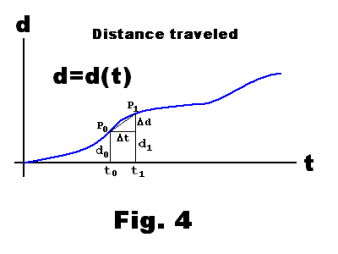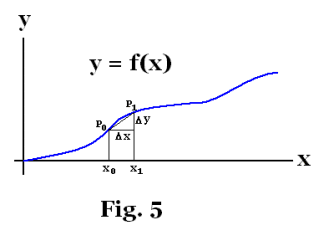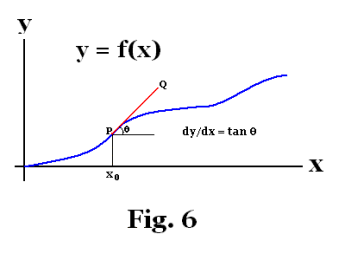
Website owner: James Miller
THE DERIVATIVE

The two central concepts of calculus are the concepts of the derivative and the integral. The roots of these concepts go back to the work of Galileo and others who performed experiments involving rolling balls down inclined planes and dropping objects from heights in attempts to discover basic laws of nature. The experiments revealed that when balls roll down an inclined plane their speed increases as they roll. Let us repeat one of Galileo’s experiments. Raise one end of a board so that it is just steep enough to cause a ball to roll down it at the rate of 1 foot in the first second. The apparatus is shown in Fig. 1. As the ball rolls down the board, we note its position at one second intervals. The data obtained is shown in Fig. 2. From the table we see that the average speed during the first second was 1 ft/sec, the average speed during the second second was 3 ft/sec, the average speed during the third second was 5 ft/sec, etc. Experiments such as these were done with varying slopes for the inclined plane and when the angle was increased to 90 degrees the experiment gave the limiting case of free-fall.

These experiments forced Galileo and his contemporaries to deal, in their analysis, with speeds that vary with time, changing from moment to moment. That is, it forced them to deal with problems involving nonuniform motion. The experiments raised questions like: If the speed is continually changing, how does one determine the speed at a particular point in time? How do you compute distance traveled when you have a speed that is constantly varying? How do you analyze problems mathematically with a speed that is varying from one moment to the next? How do you describe such problems mathematically? How do you think about such problems? In fact, the answer to the first question goes directly to the heart of the concept of the derivative and the answer to the second question goes directly to the heart of the concept of the integral.
So let us ask, “How do you determine the speed of something at a particular instant of time? We have a basic formula that relates time, speed, and distance traveled in
![]()
or, more concisely,
![]()
where s is the speed and Δd is the distance traveled over the time interval Δt.

If a bee flies 20 feet in 10 seconds, his average speed is 2 ft/sec over the 10 second period. If we observe the distance he travels over a 1 second interval instead of a 10 second interval and observe that he went 1.8 feet in one second, then his average speed was 1.8 ft/sec in that second during which he was observed. If we keep reducing the interval size Δt over which he is observed to 0.1 sec, .01 sec, etc. we get closer and closer to his instantaneous speed. In other words, his instantaneous speed si is given by
![]()
Let us suppose we attach a GPS device to a mountain lion that allows us to track his position over the course of a period of time. Assume we have rigged it to act as a kind of odometer which feeds us distance traveled as a function of time, starting with some initial time t = 0. Let us now plot the distance traveled vs. time and ask ourselves what his speed is at some particular time t = t0. See Fig. 3. The plot shows the distance traveled d as a function of time, t i.e. a plot of d = d(t). We will now compute his speed at time t0 using formula 1). We define

d0 = d(t0)
d1 = d(t1)
where d0 represents the distance traveled at time t0 and d1 represents the distance traveled at time t1.
See Fig. 4.
Then
Δd = d1 - d0 = d(t1) - d(t0)
Δt = t1 - t0
and the instantaneous speed si at time t0 is

Thus we have the expression for the instantaneous speed at time t0 when distance traveled is given as a function of time as d = d(t).
Note in Fig. 4 that as Δt approaches zero point P1 approaches point P0 and the line P0P1 becomes, in the limit, the tangent line to the curve at point t = t0. Thus the instantaneous speed at point t = t0 is equal to the slope of the tangent line at point t = t0.
Galileo and his contemporaries derived the above formula for the instantaneous speed at a point and then applied the same reasoning and formula to find the instantaneous acceleration at a point. They regarded speed as the function varying with time, used s = s(t) instead of d = d(t), and, applying the same logic, arrived at
![]()
where ai is the instantaneous acceleration at point t0.
We are now ready to present the definition of the derivative of a function.
Def. Derivative of a function y = f(x). The derivative of a function y = f(x) with respect to x at the point x = x0 is defined as


provided that limit exists. See Fig. 5.
It will be observed that this equation is identical to 2). The only difference is that the variables of 2) have been replaced by x and y. Thus we see that the definition of the derivative is a direct outgrowth of 2). It is, in fact, a generalization of 2) in which the independent variable is allowed to be anything, not just time, and the dependent variable is also allowed to be anything. Equations 2) and 3) then becomes special cases of 4), particular applications of 4). By making this generalization from 2) to 4) in which the independent and dependent variables can be anything, the derivative finds application in many branches of science. It is used extensively in physics and chemistry and in many other fields.

In Galileo’s time they were applying formula 2) to various quantities viewed as functions of time e.g. distance traveled, speed, probably other things. However, viewing things other than time as the independent variable probably required some jump of intellect. It was probably a matter of some time before this generalization was made. Why? Because time varies in a natural way. Other variables don’t. It is natural to view time as a variable. It is not natural to view other variables as varying. It is not natural to think of the radius r in the formula A = π r2 as an independent variable that can vary. That idea took a jump of intellect.
The derivative of a function y = f(x) at a point x = x0 represents the instantaneous rate of change of the function f(x) with respect to the independent variable x at the point x0. It is equal to the slope of the tangent to the function at point x = x0. In other words, dy/dx = tan θ where θ is the angle between the tangent to the function at x = x0 and the x axis. See Fig. 6.
The definition of the derivative of a function is usually given in a slightly different form from what we have given in 4) above. It is:
Def. Derivative of a function y = f(x). The derivative of a function y = f(x) with respect to x is
![]()
provided that limit exists.
In this definition x corresponds to x0 of 4) above and the derivative is evaluated at point “x”.
The derivative of a function y = f(x) is itself a function and is denoted by such symbols as
![]()
The derivative, evaluated at a point a, is written

Finding derivatives.
Problem. Find the derivative of the function y = x2 + 3x + 5.
Solution. Using 5) above
f(x + Δx) = (x + Δx)2 + 3(x + Δx) + 5 = x2 + 2xΔx + Δx2 + 3x + 3Δx + 5
f(x) = x2 + 3x + 5
f(x + Δx) - f(x) = (2x + 3)Δx + Δx2
![]()
![]()
The procedure just illustrated is the general procedure used in finding derivatives. But it is the long and hard way. We will learn that this procedure has been used to find general formulas for differentiating functions. Using the derived formulas makes the process of differentiating functions much easier than going through the above process each time.
References.
Dull, Metcalfe, Brooks. Modern Physics. pp. 169 - 170
Jesus Christ and His Teachings
Way of enlightenment, wisdom, and understanding
America, a corrupt, depraved, shameless country
On integrity and the lack of it
The test of a person's Christianity is what he is
Ninety five percent of the problems that most people have come from personal foolishness
Liberalism, socialism and the modern welfare state
The desire to harm, a motivation for conduct
On Self-sufficient Country Living, Homesteading
Topically Arranged Proverbs, Precepts, Quotations. Common Sayings. Poor Richard's Almanac.
Theory on the Formation of Character
People are like radio tuners --- they pick out and listen to one wavelength and ignore the rest
Cause of Character Traits --- According to Aristotle
We are what we eat --- living under the discipline of a diet
Avoiding problems and trouble in life
Role of habit in formation of character
Personal attributes of the true Christian
What determines a person's character?
Love of God and love of virtue are closely united
Intellectual disparities among people and the power in good habits
Tools of Satan. Tactics and Tricks used by the Devil.
The Natural Way -- The Unnatural Way
Wisdom, Reason and Virtue are closely related
Knowledge is one thing, wisdom is another
My views on Christianity in America
The most important thing in life is understanding
We are all examples --- for good or for bad
Television --- spiritual poison
The Prime Mover that decides "What We Are"
Where do our outlooks, attitudes and values come from?
Sin is serious business. The punishment for it is real. Hell is real.
Self-imposed discipline and regimentation
Achieving happiness in life --- a matter of the right strategies
Self-control, self-restraint, self-discipline basic to so much in life